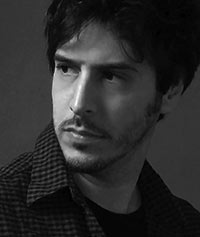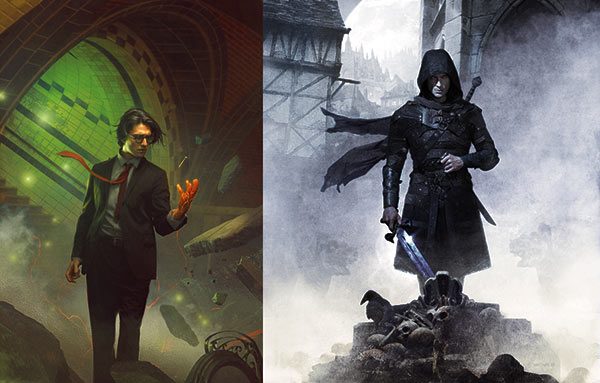Spotlight on Chris McGrath
 CHRIS MCGRATH was born in the Bronx and has lived in and around NYC his whole life. At an early age he became interested in art, especially science fiction and fantasy. After graduating from The School of Visual Arts in NYC, Chris gave guitar lessons for several years before beginning his career in 2001. Since then he has done covers for #1 New York Times best selling authors such as: Jim Butcher, Brandon Sanderson and Seanan McGuire. He also has been a Hugo Award nominee in the Best Professional Artist category two times. He also teaches a class in illustration at The School of Visual Arts in NYC for the fall and spring semesters.
CHRIS MCGRATH was born in the Bronx and has lived in and around NYC his whole life. At an early age he became interested in art, especially science fiction and fantasy. After graduating from The School of Visual Arts in NYC, Chris gave guitar lessons for several years before beginning his career in 2001. Since then he has done covers for #1 New York Times best selling authors such as: Jim Butcher, Brandon Sanderson and Seanan McGuire. He also has been a Hugo Award nominee in the Best Professional Artist category two times. He also teaches a class in illustration at The School of Visual Arts in NYC for the fall and spring semesters.
What was your introduction to working in the field of science fiction and fantasy art? What were the influences that drew you in?
Like many artists, I was always drawing for as long as I can remember, and I never stopped. My mother was always drawing as well, though she did not work professionally as an artist, but I did find it inspirational nonetheless.
As I got older, I was drawing comics with friends, etc., but the big moment came when I was 11 or 12, over at my uncle’s apartment, and he had a Frank Frazetta book on table. That instantly blew me away. It was one of those crazy moments in life where everything became clear, and I realized this is what I wanted to do for a living. I got as serious as I could, doing studies from Frazetta’s art and other artists like Keith Parkinson, Larry Elmore, Michael Whalen, John Buscema, and Neil Adams. Those are my early building blocks. My uncle was my main influence in getting me going and keeping me a bit competitive. He’s a super talented artist as well, though he never worked professionally either. During high school I kept up the drawing but also became a bit distracted with learning guitar and playing in a band. I think if I had gotten a guitar when I was 10 or so, my future may have been different.
In college I finally got some structured training at the School of Visual Arts, where I went in the early to mid-’90s. I was exposed to so many other students with talent, and some very good teachers. Seeing that many talented people in one place was an eye opener in terms of understanding how competitive the illustration world was.
While I was at SVA, I studied with realist painter Steven Assael, and that changed everything. That was my first exposure to serious academic painting and drawing. It was incredible for me to actually see someone painting from life and doing these amazing pieces right in front of me. I spent the next several years, painting and drawingfrom life and learning from a wide range of artists outside of science fiction and fantasy painters, such as Rembrandt, Van Dyke, Sargent, etc.
I did consider the fine art world, but my heart and original inspiration was in sci -fi book covers, so I stuck with that, with the intent of bringing a fine art twist to the genre.
While I was at SVA I met the fantastic artist Dorian Vallejo (son of Boris). His work was incredible. He was a few years older than me, but to see someone at such a young age doing that level of work really guided me and showed me this was an achievable goal.

Talk a bit about one of your most interesting illustration projects.
For the past two and a half years I’ve been working on the special edition of Heretics of Dune. I’m a massive Dune fan, so when I got the offer to work on this book, I jumped on it. I knew taking it on would stress me out because I’m such a fan, and that I would be overly picky and critical of everything, but I couldn’t say no even though my schedule was packed! One of the main enjoyments of working in Frank Herbert’s world is that, creatively, it leaves a lot of room for visual interpretation and creativity. There’s a lot of cool weirdness to Dune, so you can let your imagination run wild. It’s a very personal project for me and I’ve put a lot of care into this… maybe too much! What does your workflow look like?
It’s changed a bit over the years. In the early part of my career, the ideas came much faster. After a couple of hundred covers, it gets more difficult. Concepting is actually the most time-consuming part for me these days. The process goes like this most of the time: The publisher will give me a brief description of what they want. Usually, it’s pretty open in terms of how I want to approach and execute the cover. It doesn’t have to be exact to the story (often the novel isn’t even finished yet), but it needs to capture the spirit of the book and character. First, I’ll do sketches for my art director, and they’ll give me the go-ahead on one. At that point the next thing I do is my photoshoot for my figure reference. I build my 3D references, and once I have all that together, I start painting. Quite often the piece will dictate itself as I work on it, so changes will be made as I go along, and it can look a bit different from the original sketch. But as long as the client is happy with what you’ve done, it’s okay.
How do you keep it fresh for yourself and keep learning new techniques and improving your craft?
Though I work digitally today, I’m an oil painter by training. My first book cover was done in oil. Early on, my approach to learning Photoshop was through the way I did oils, and I tried to translate that process into a new workflow. For many years, Photoshop was the only software I used, but in 2019 I started learning 3D software such as Zbrush and Octane Render. These programs are a game-changer. Because I work very realistically, everything needs to be at the same level and accuracy in terms of detail and lighting. Those programs allow me to build my own little movie sets with props and photoreal backgrounds in a way I could not do through photographed reference. With 3D, I have total control over everything, which is fantastic. Like many artists these days, I’m blending painting with 3D. The 3D world is time consuming, complicated and vast, but worth learning. That said, I still use real human models for my figure reference. It’s definitely important to keep evolving as an artist, and there are so many great tools out there these days to engage with.
Is there one thing you wish you could have learned early on about making art or working as a commercial artist, from someone who was experienced in the field, that you would like to share with other artists?
You need a lot of patience when trying to find work and build your clientele. Everyone has a different story as to how they became a full-time illustrator, but for most people, including myself, it takes a number of years. Those years will really test you because you don’t know if it’s actually all going to work out for you. If you really, truly love what you do, you just have to stick with it and suffer a bit until you get a break. Even then it will take a while build steady work, but if you are reliable and easy to work with, things will pick up over time, and before you know it, you will look back in disbelief that you actually arrived. It’s a great feeling when you realize it’s a full-time gig. But once you have your full-time career as an artist… don’t get too comfortable! Art is a lifelong learning experience, and you have to keep evolving and learning new techniques to keep yourself relevant.
The last thing I’d like to tell young artists is, don’t look for a style, or you’ll just end up copying someone. Just draw and paint what’s important to you, and your style will find you. Is there something about what you do as an artist working in the SF/F field, or an upcoming project, that you’d like to tell our readers about?
Centipede Press’s Heretics of Dune, as I mentioned earlier. I’m doing illustrated editions of the Dresden Files for Grim Oak Press. It’s really fun to finally get to do big scenes and show the other characters from the series. I’ll be doing those every year, along with my regular book cover jobs and teaching.
–Chris McGrath
 While you are here, please take a moment to support Locus with a one-time or recurring donation. We rely on reader donations to keep the magazine and site going, and would like to keep the site paywall free, but WE NEED YOUR FINANCIAL SUPPORT to continue quality coverage of the science fiction and fantasy field.
While you are here, please take a moment to support Locus with a one-time or recurring donation. We rely on reader donations to keep the magazine and site going, and would like to keep the site paywall free, but WE NEED YOUR FINANCIAL SUPPORT to continue quality coverage of the science fiction and fantasy field.
©Locus Magazine. Copyrighted material may not be republished without permission of LSFF.








